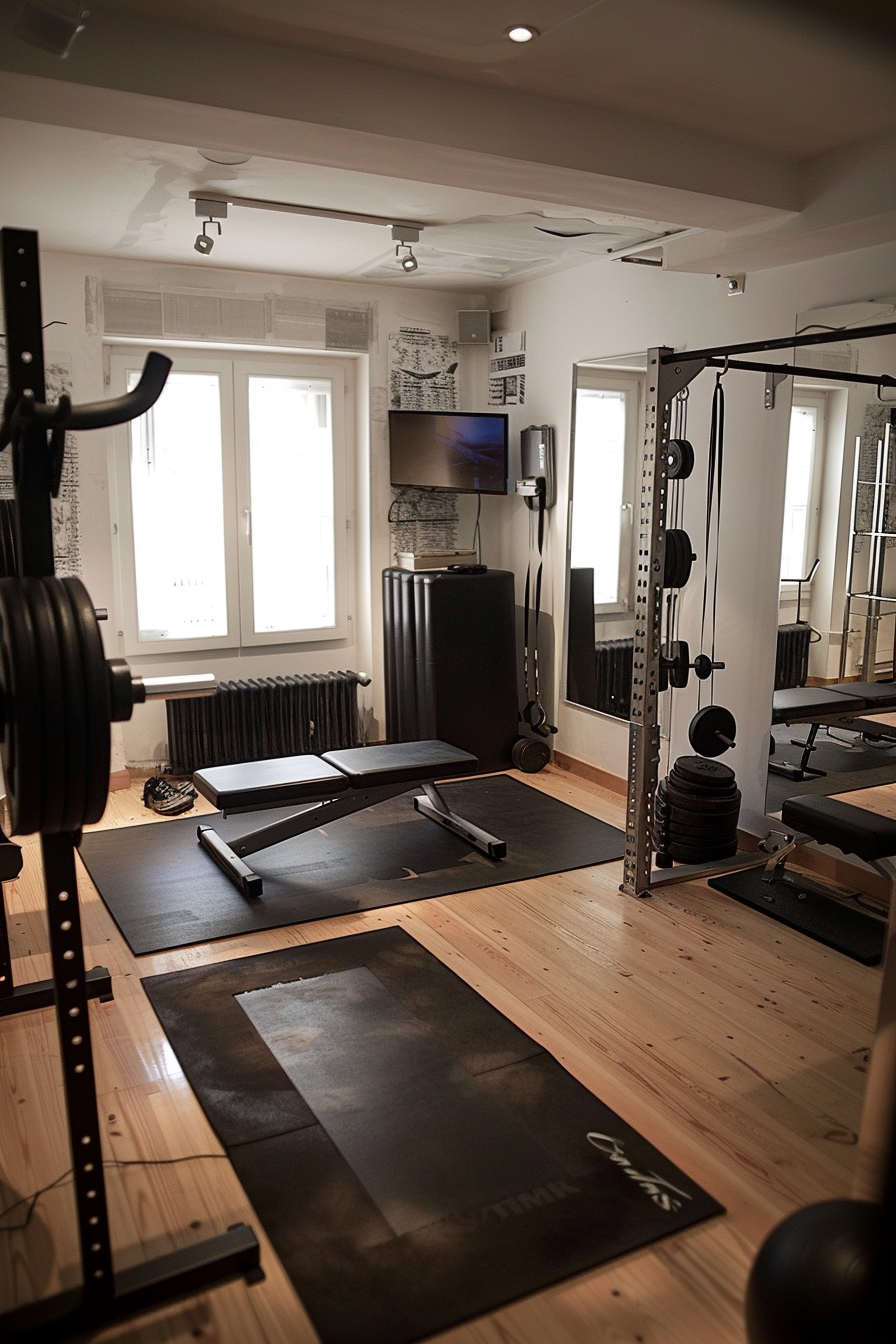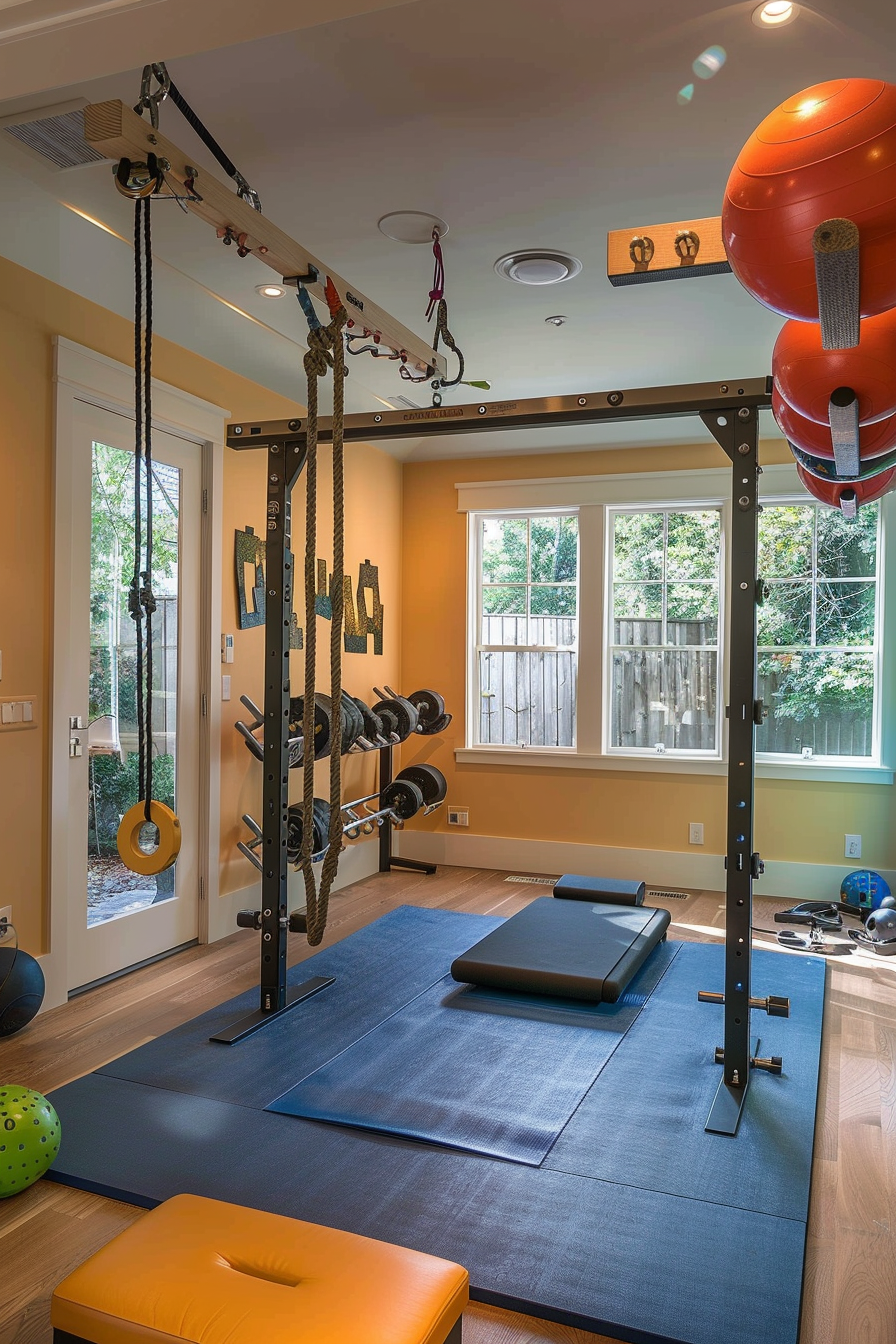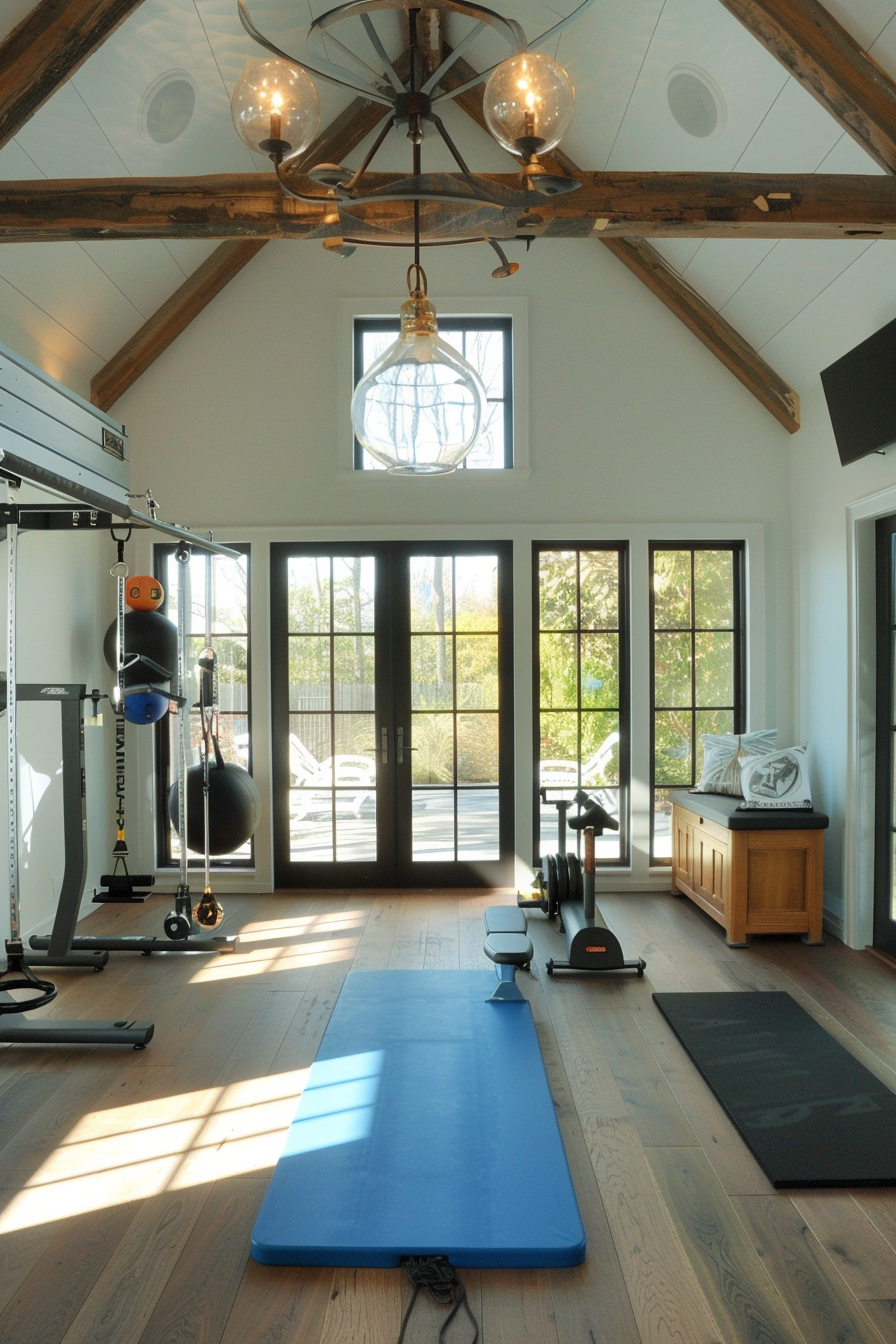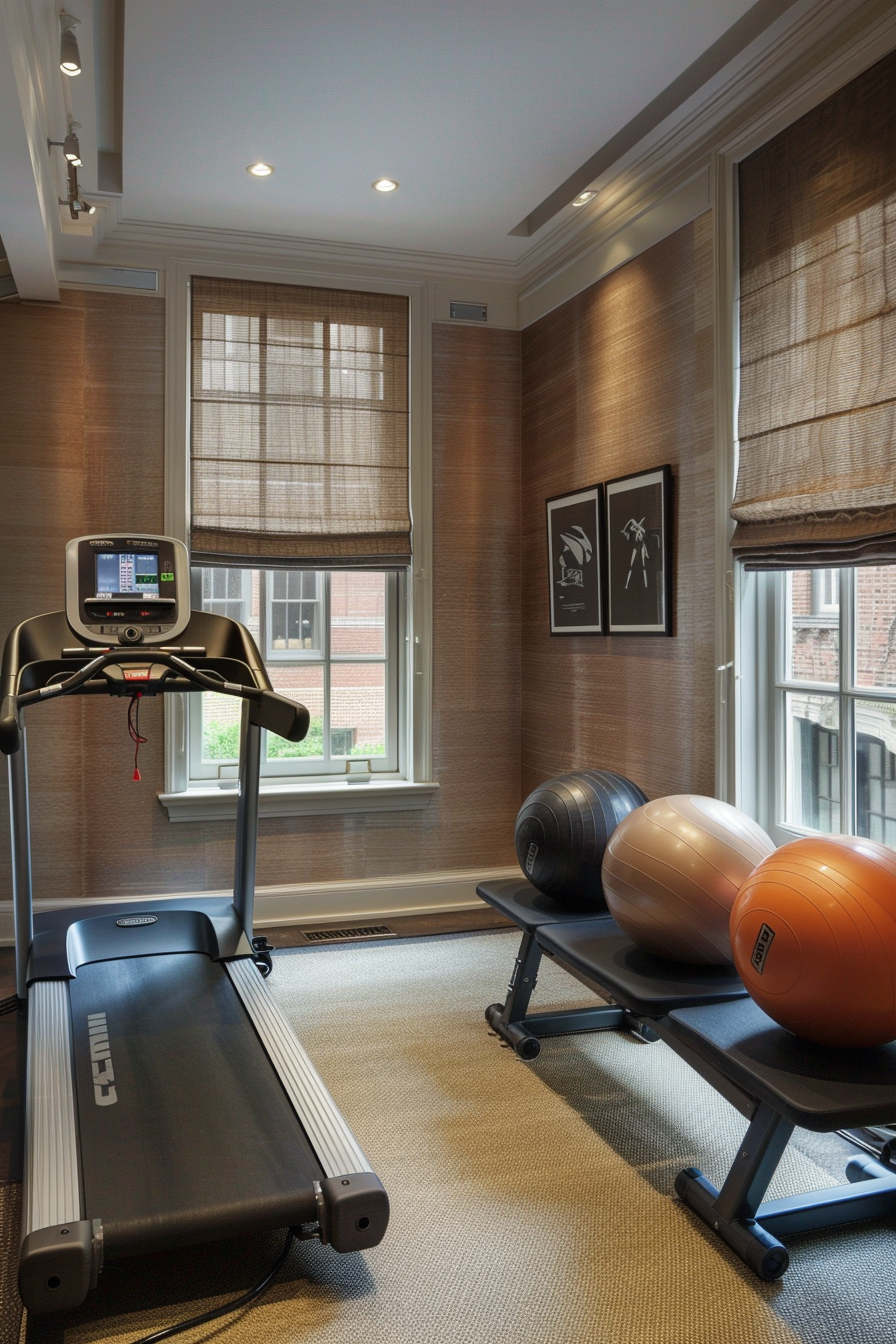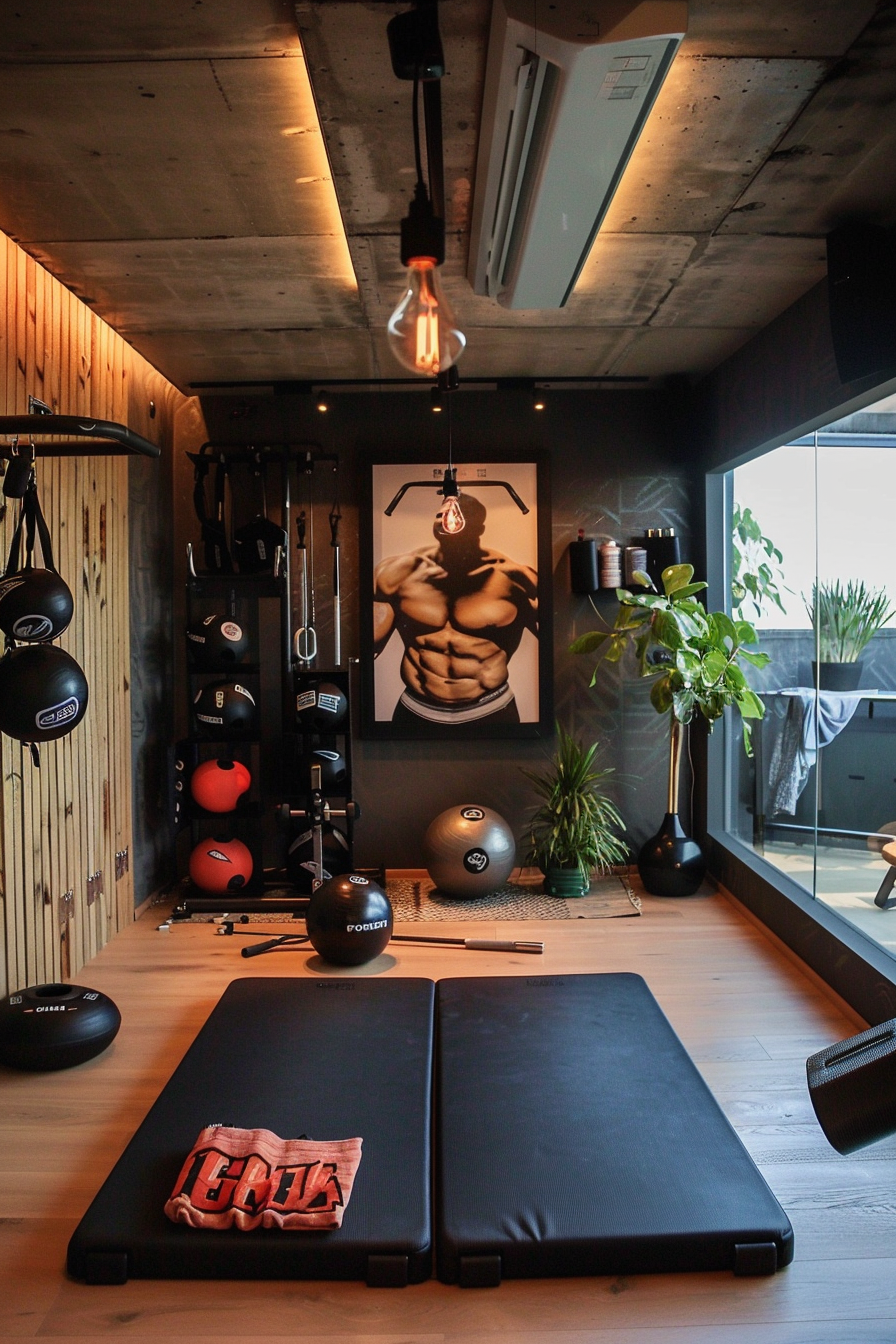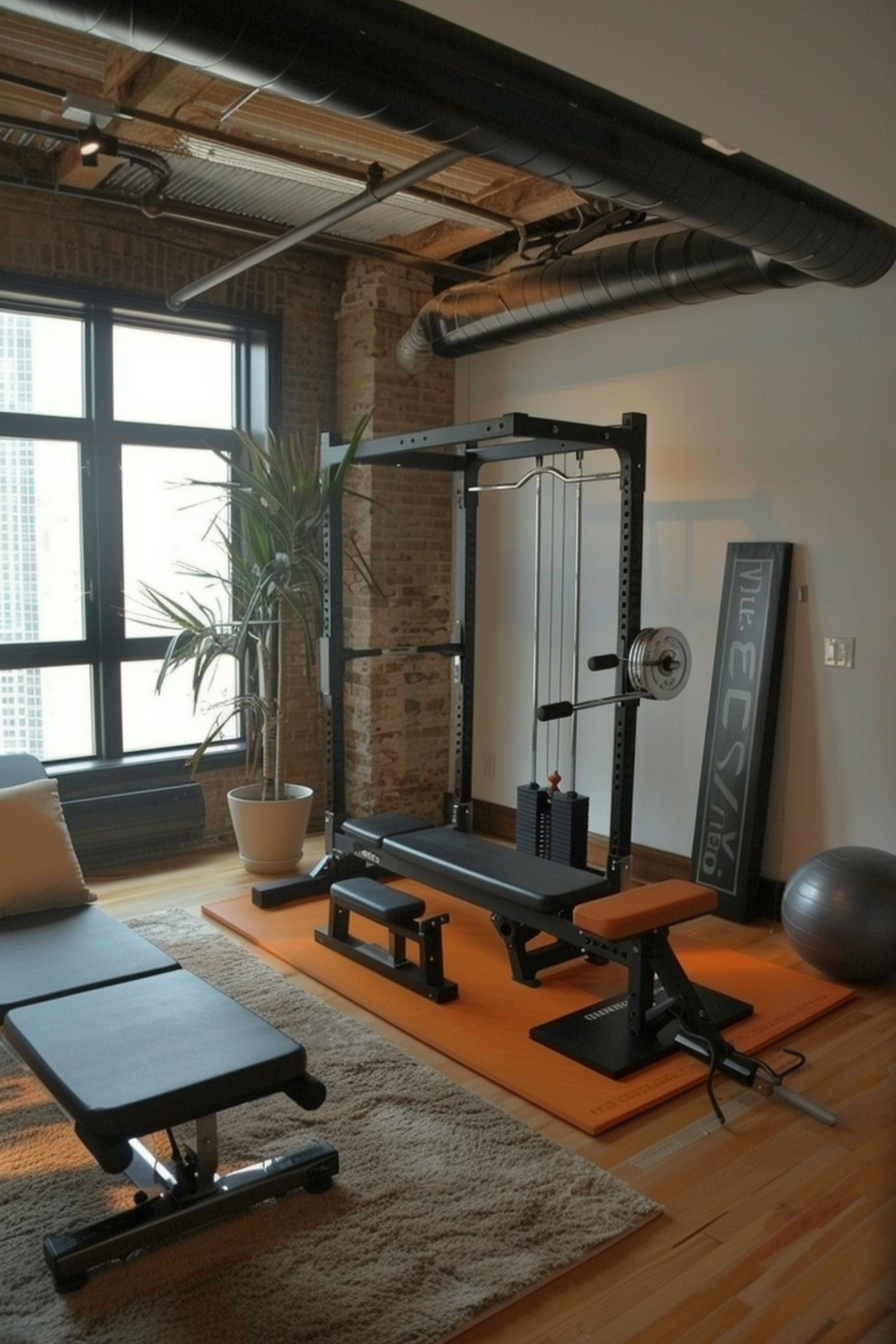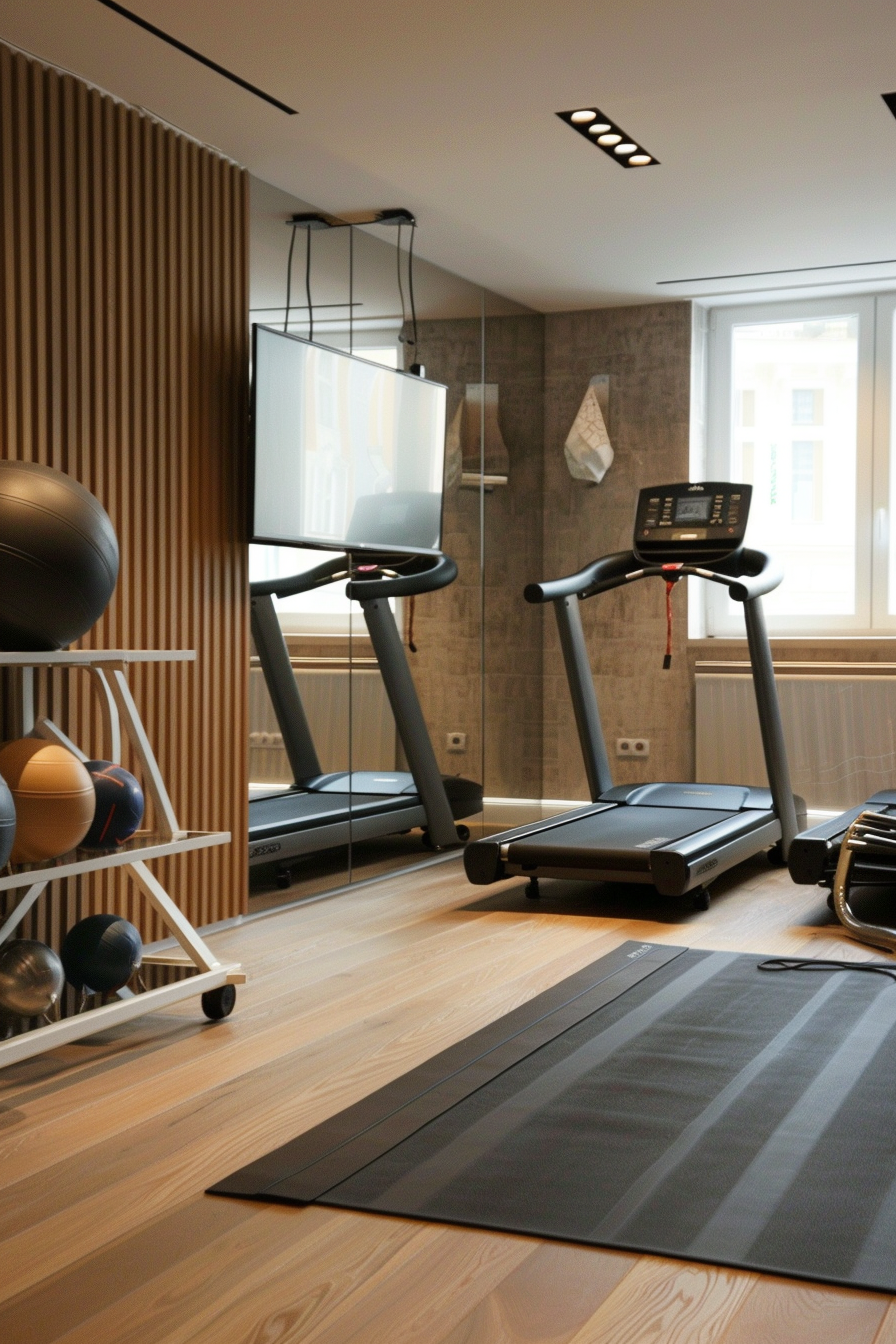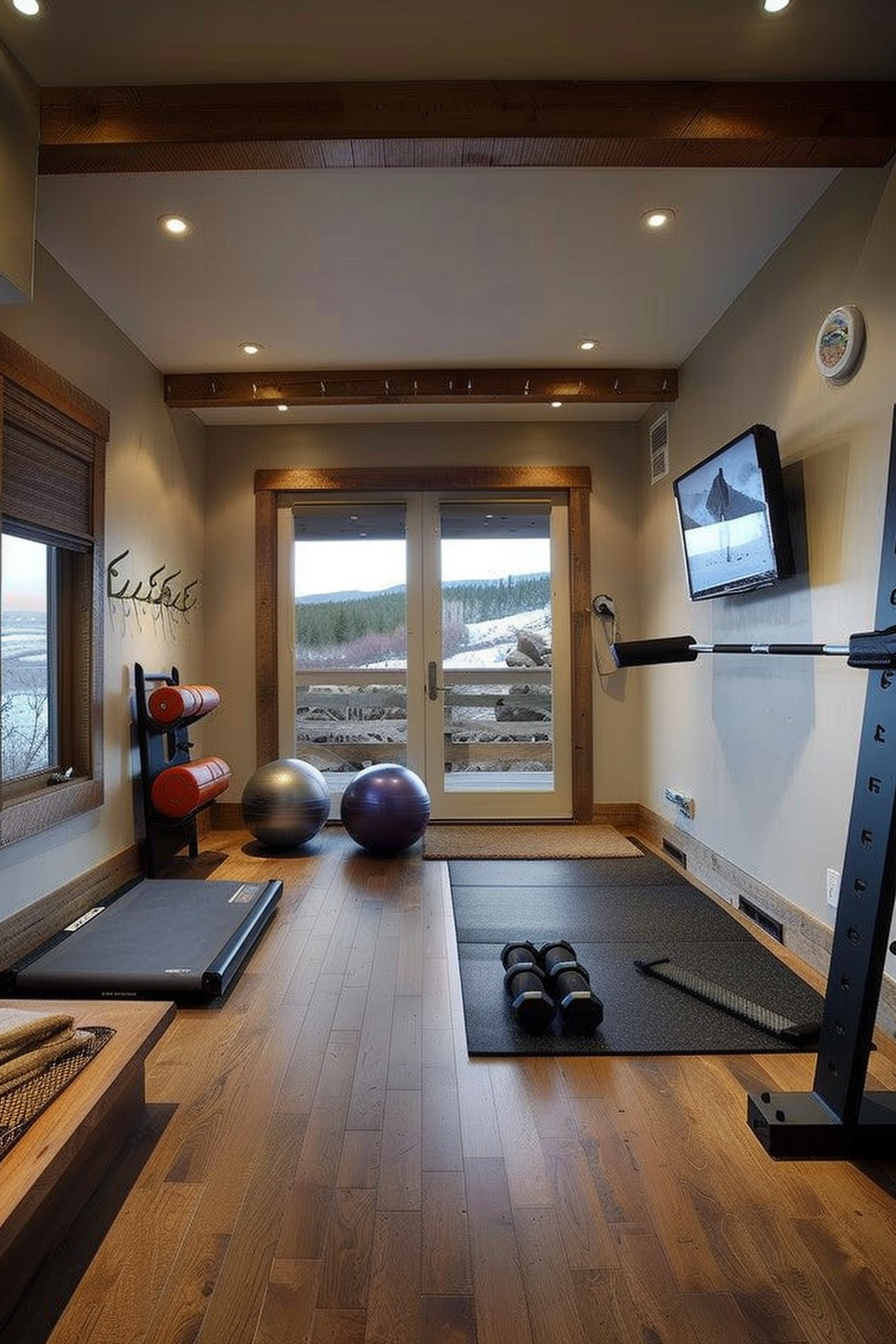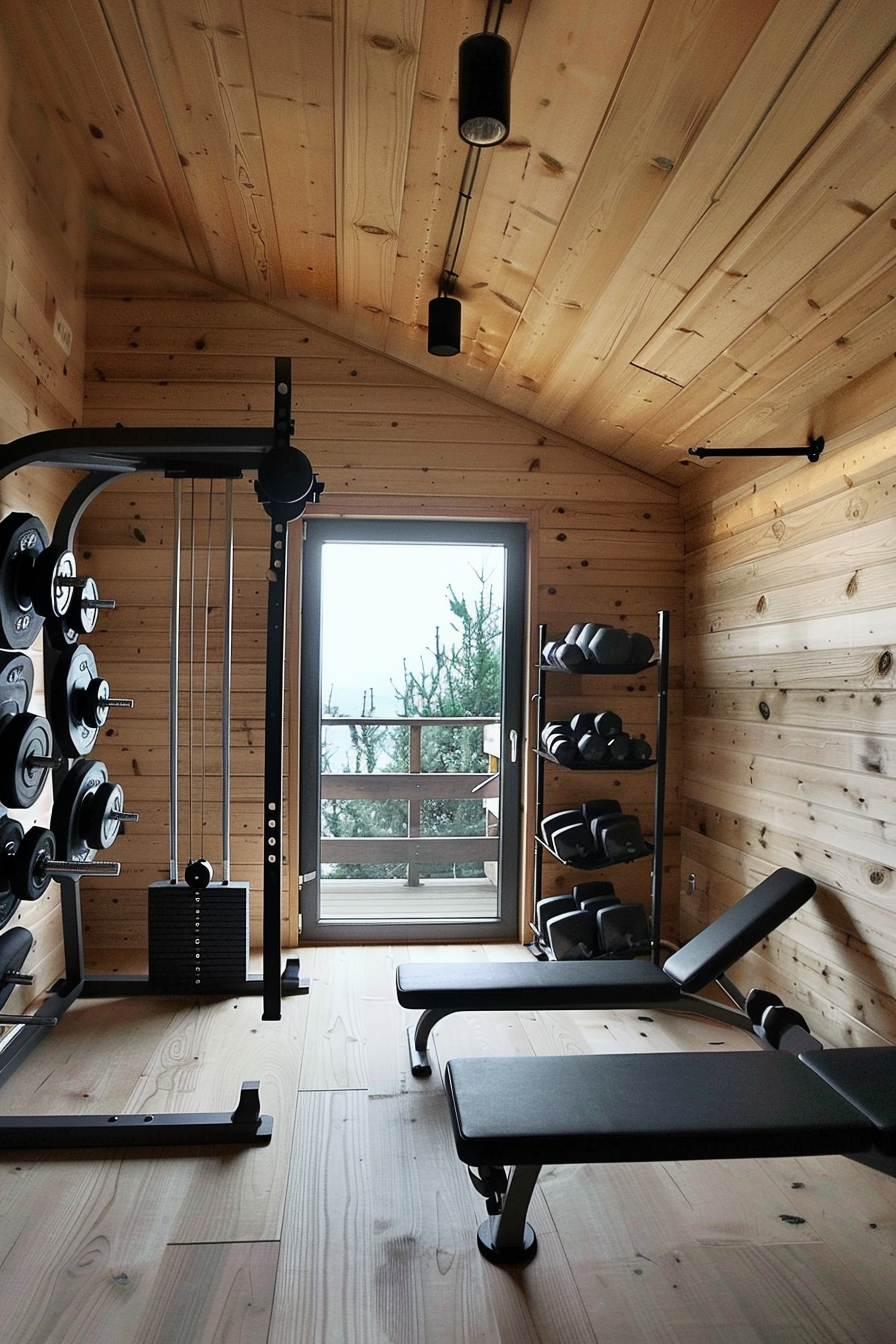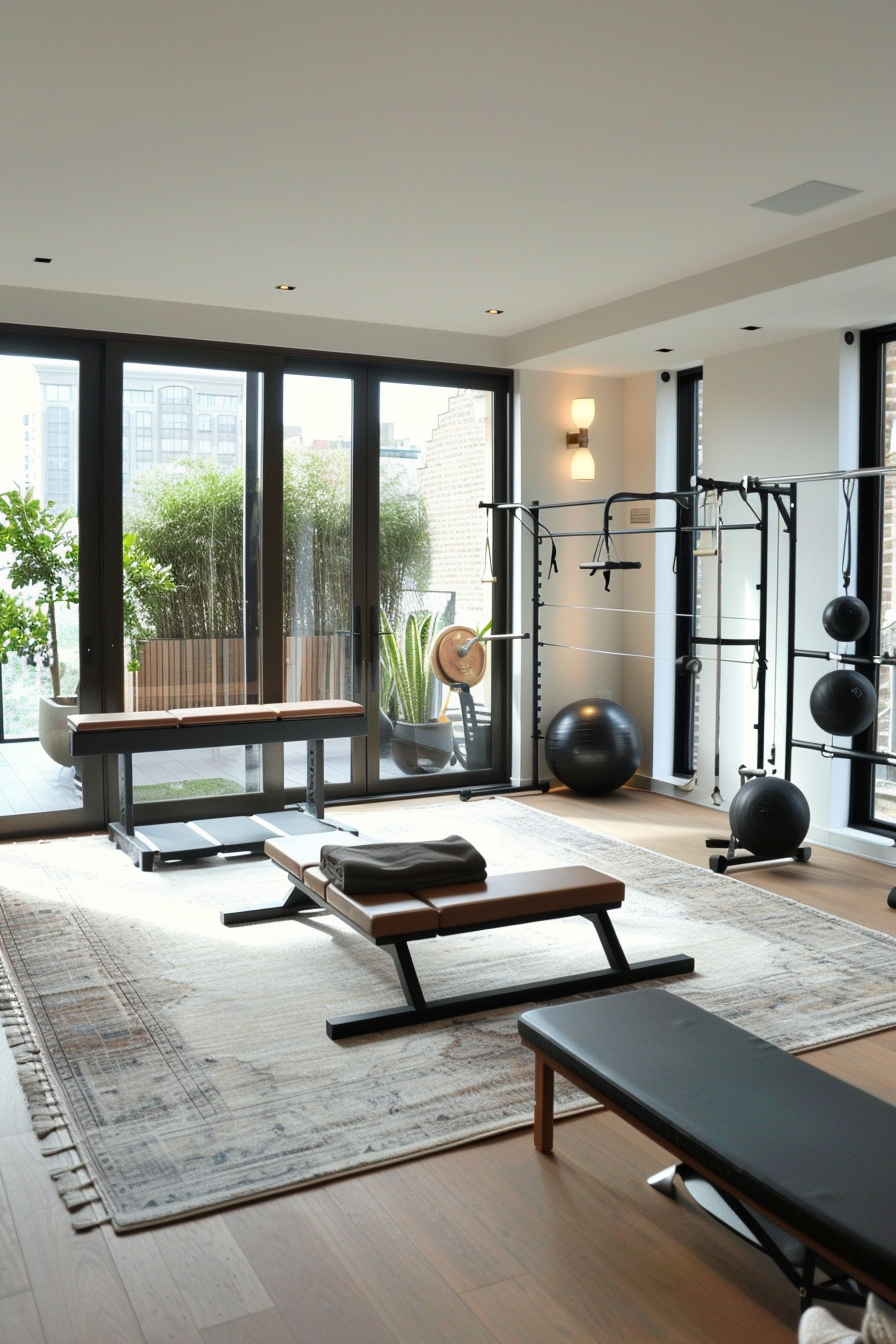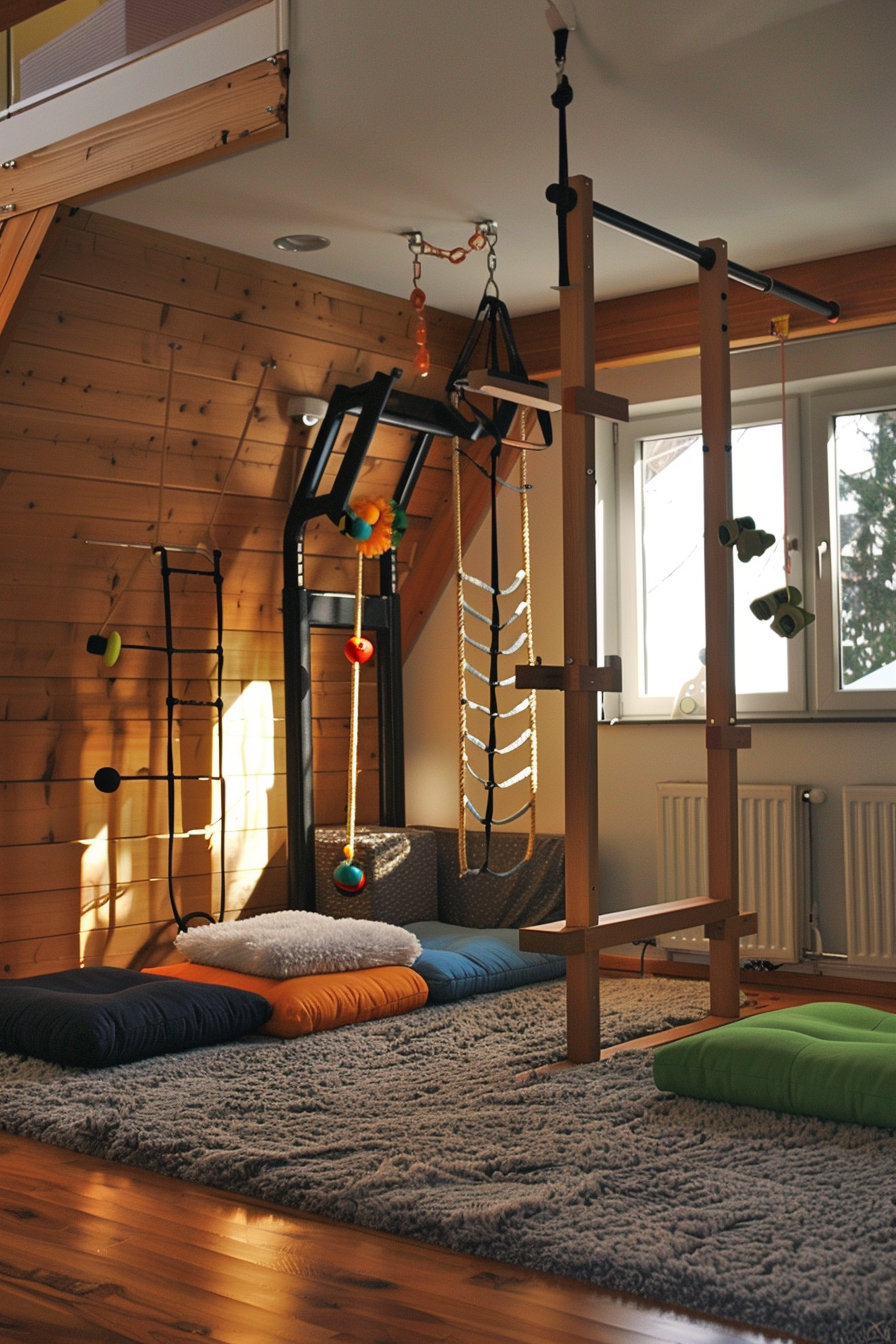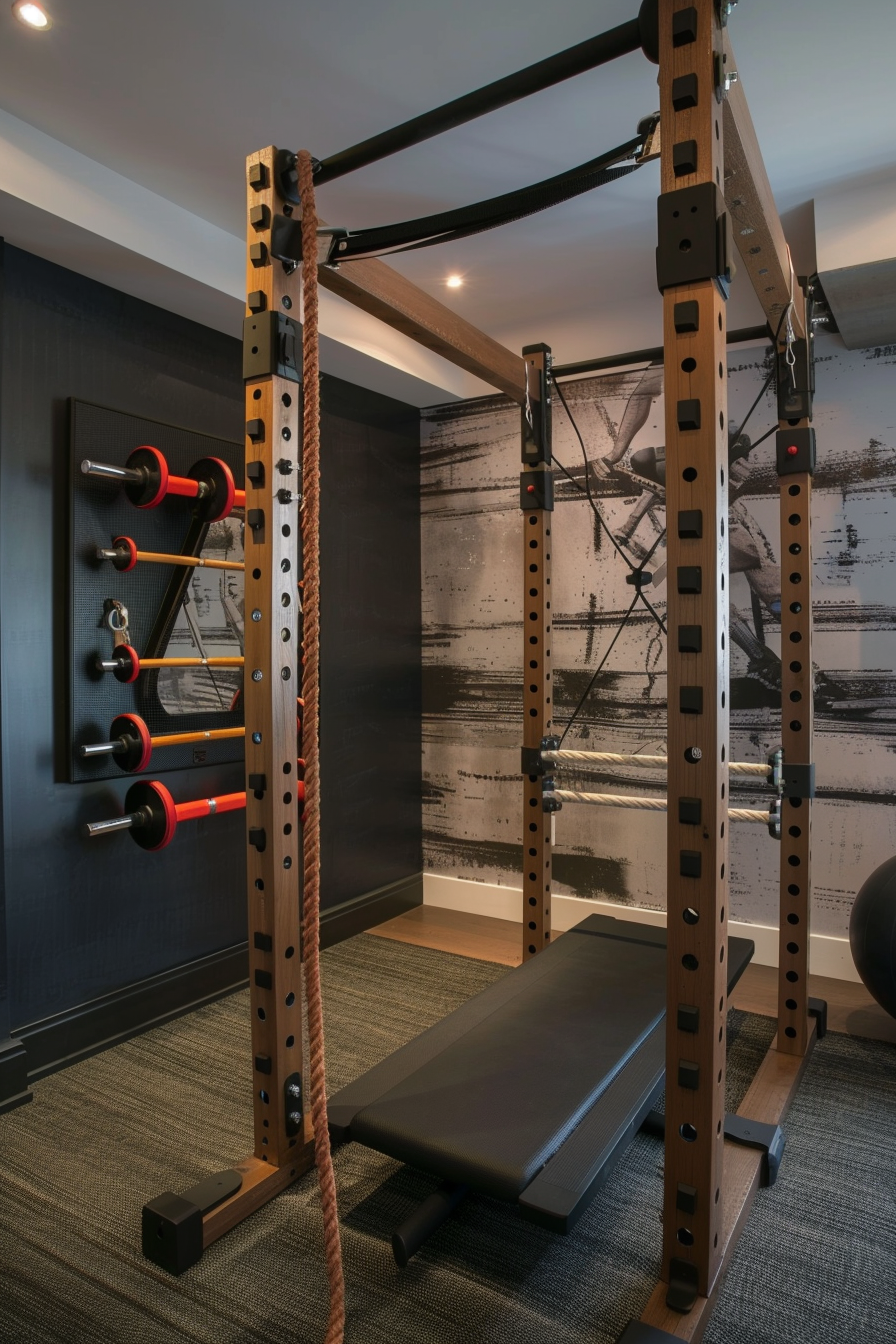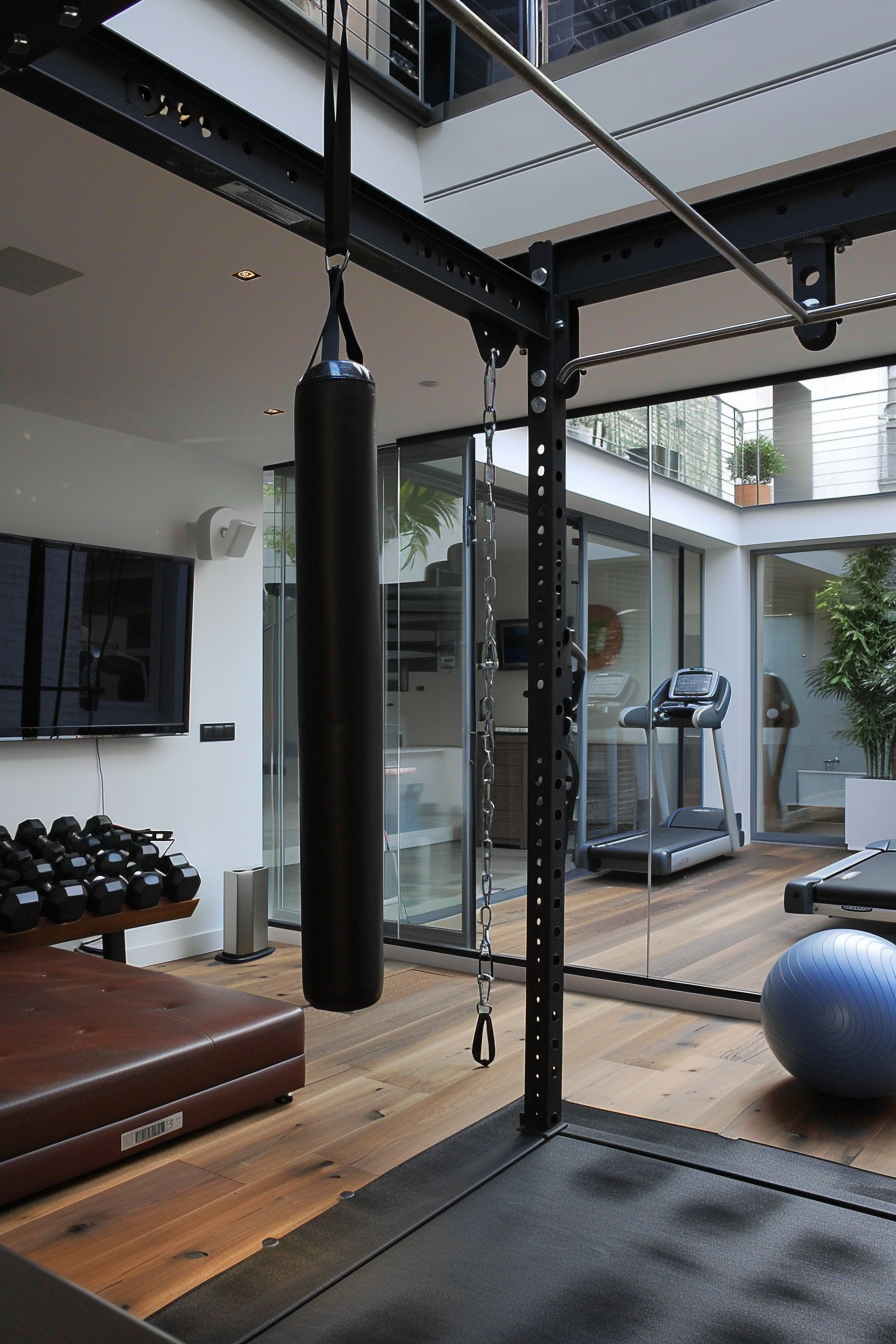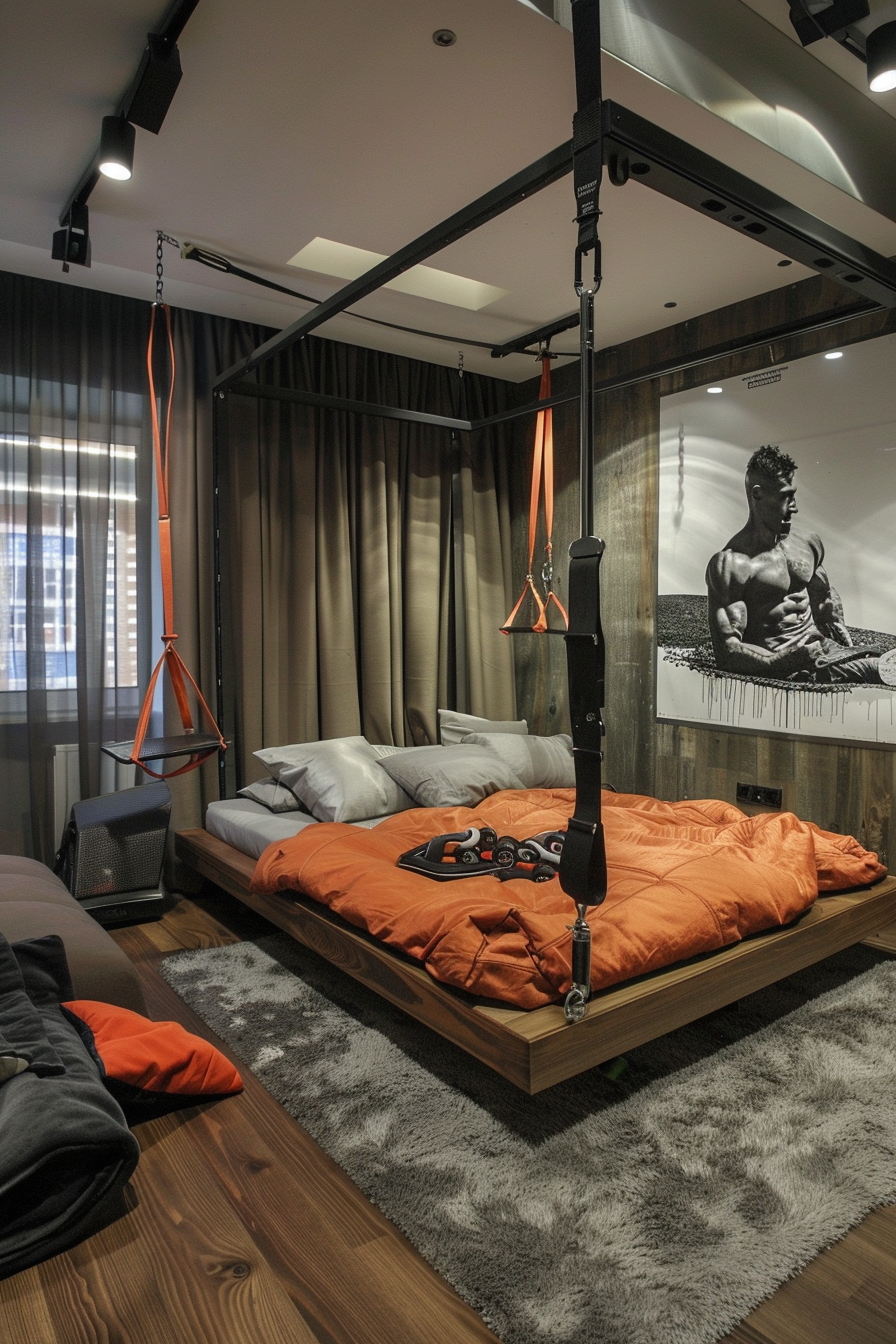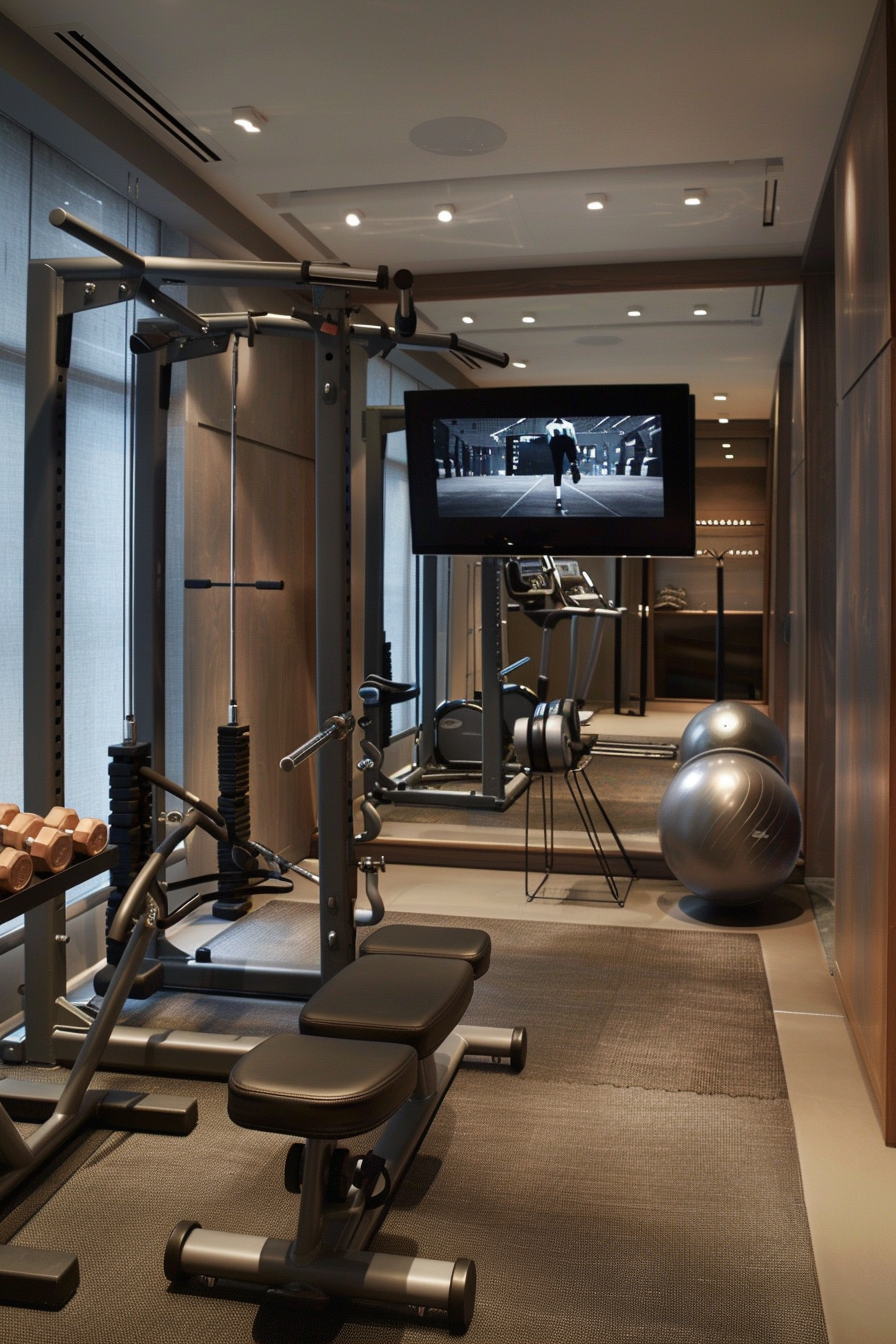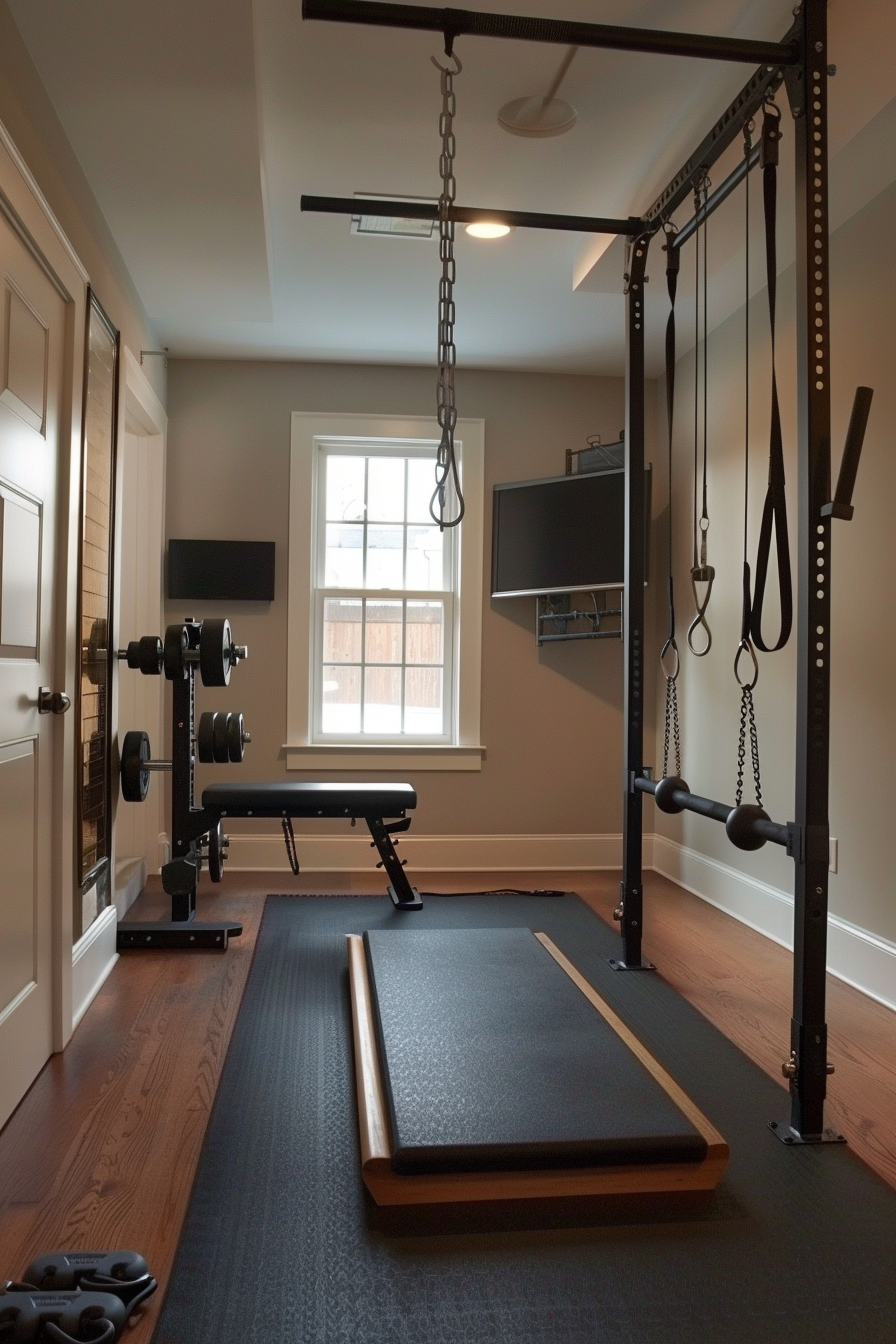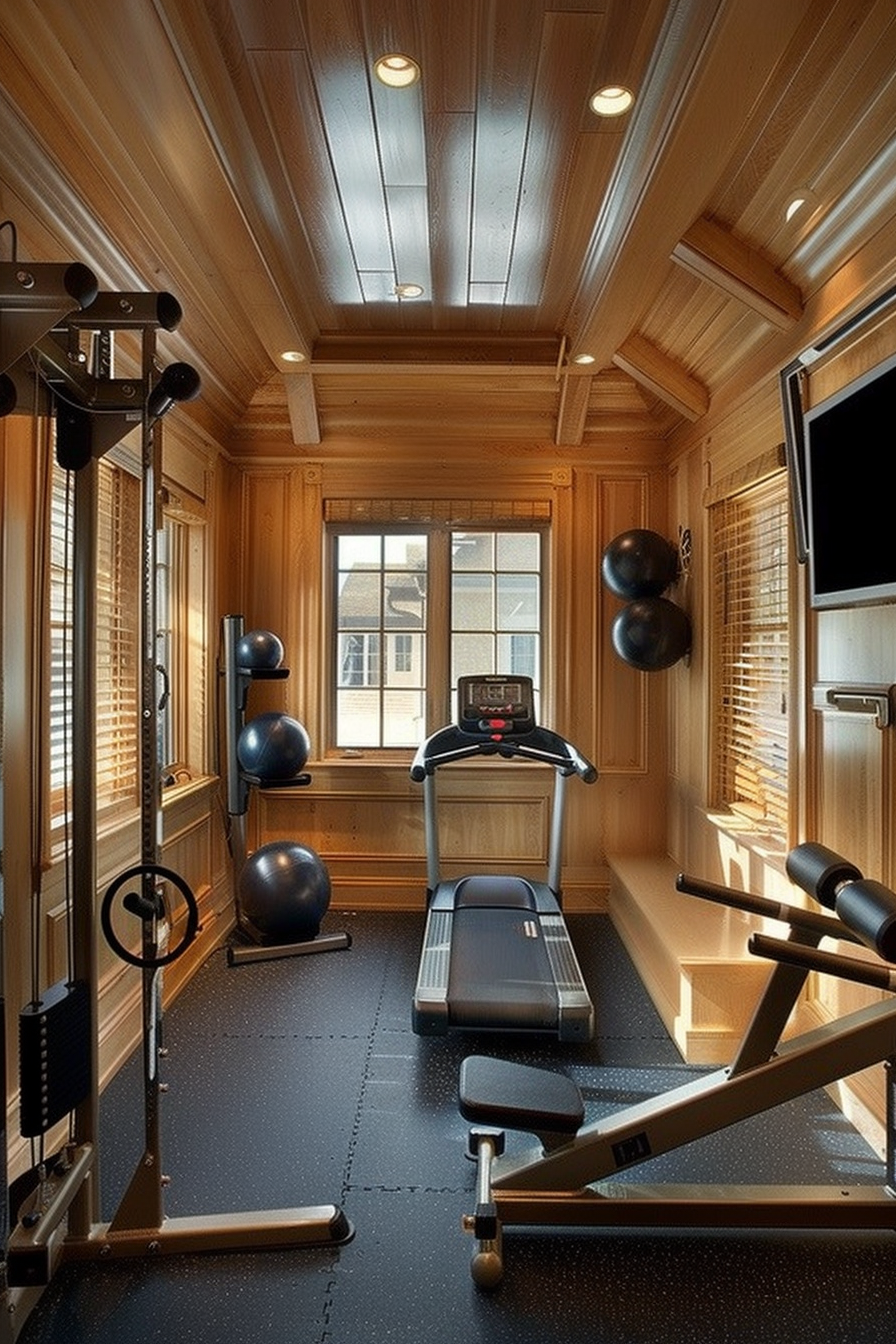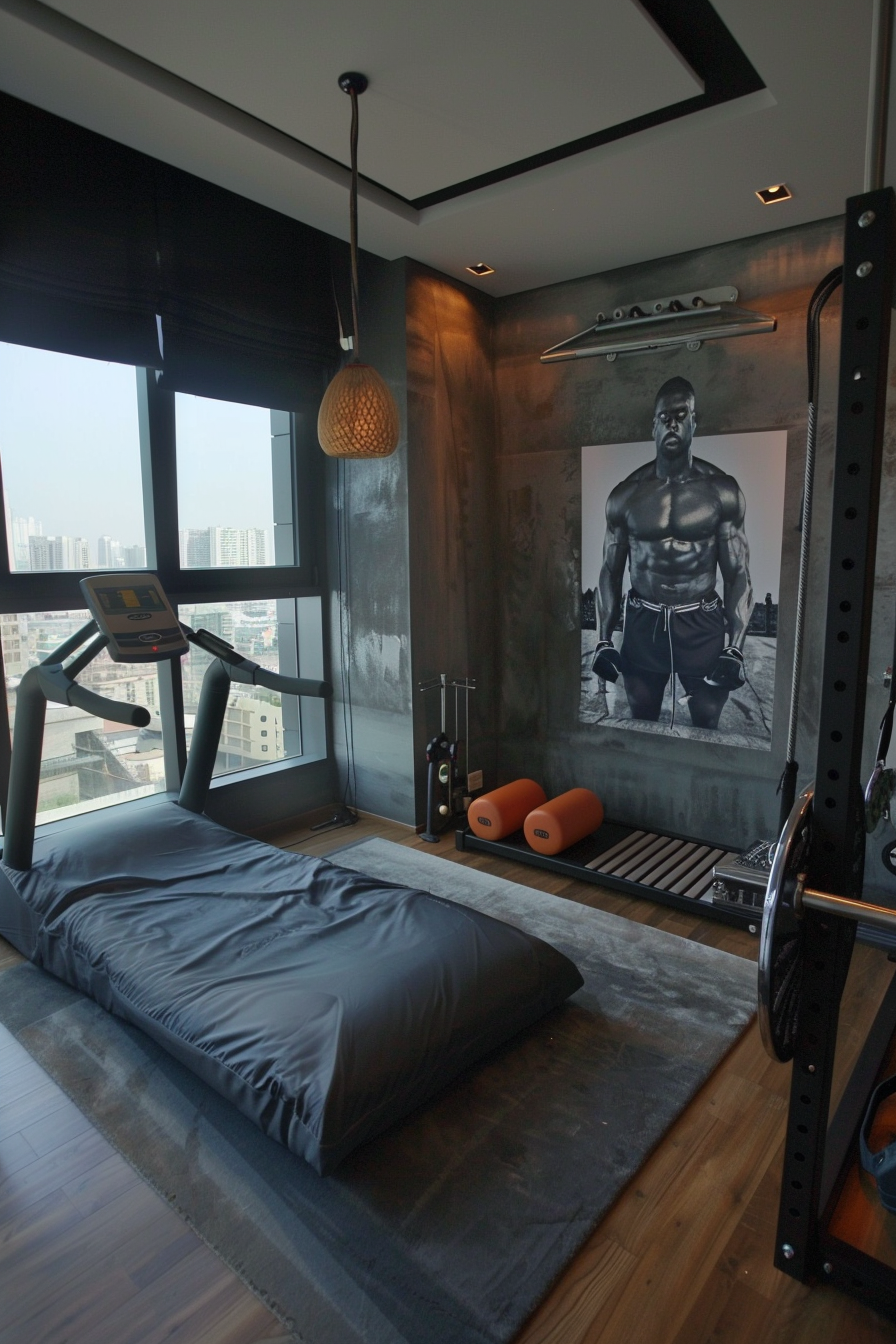I never thought I’d be the kind of person who’d love working out at home.
For years, I relied on gym memberships, fancy equipment, and group classes to stay in shape.
But then life happened—tight schedules, long commutes, and let’s be real, plenty of excuses.
I started skipping the gym more often than I’d like to admit, and soon enough, I decided to try something new.
I carved out a small space in my living room, threw down a yoga mat, and got creative.
Turns out, you don’t need a huge home or a garage full of machines to create your own mini gym.
You just need a little imagination, a touch of effort, and the right setup:
✨Click to Get My 101 FREE Designer Room Ideas
The Corner Yoga and Stretching Zone


If you’ve got an unused corner in your bedroom or living area, this one’s for you.
All you need is a yoga mat, a couple of foam blocks, and maybe a strap or two for stretching.
Roll out your mat in the corner and keep your props neatly stacked up nearby.
You can even add a small basket or shelf to store your equipment when it’s not in use.
This zone is perfect for unwinding after a long day or starting your mornings with some gentle yoga flows.
You don’t need a ton of space—just enough room to lay down and stretch your arms wide.
To make the area feel more inviting, consider adding a small plant or a scented candle.
The goal is to create a calming vibe that makes you want to spend time there.
If you’re into guided workouts, hang a tablet or phone holder on the wall so you can stream your favorite yoga classes hands-free.
Feeling fancy?
A small mirror on the wall can help you check your form and make the space feel bigger.
This setup encourages consistency because it’s always ready to go.
No excuses, no packing up gear—just step into your corner and start moving.
Resistance Band Wall Setup



Resistance bands are a game-changer for home gyms.
They’re compact, versatile, and perfect for strength training without bulky equipment.
You can turn any wall into a workout station with just a few hooks or a wall-mounted anchor system.
Install the hooks at different heights to mimic the cable machines you’d find at the gym.
This setup lets you target different muscle groups—arms, chest, back, legs—all without taking up much space.
Keep your bands organized by hanging them on the hooks when you’re not using them.
If you want to level it up, invest in a door anchor that works on any sturdy doorframe.
This way, you can use resistance bands without drilling into your walls.
The beauty of this idea is how customizable it is.
You can adjust the height, resistance level, and exercises based on your fitness goals.
Plus, resistance bands are super budget-friendly, so you won’t break the bank setting this up.
Foldable Cardio Equipment


Cardio lovers, this one’s for you.
If you think you don’t have room for a treadmill or exercise bike, think again.
Foldable options are a lifesaver for small spaces.
Look for compact treadmills or bikes that can be folded and stored under your bed or in a closet.
When you’re ready to work out, just pull it out, set it up, and you’re good to go.
Some models even come with wheels for easy maneuvering.
The best part?
You don’t need a dedicated room for this.
Your living room, bedroom, or even a hallway can work as your workout zone.
If you’re into tracking your progress, many foldable machines come with built-in monitors or Bluetooth connectivity.
This means you can keep tabs on your speed, distance, and calories burned, all while saving space.
Dumbbell Corner
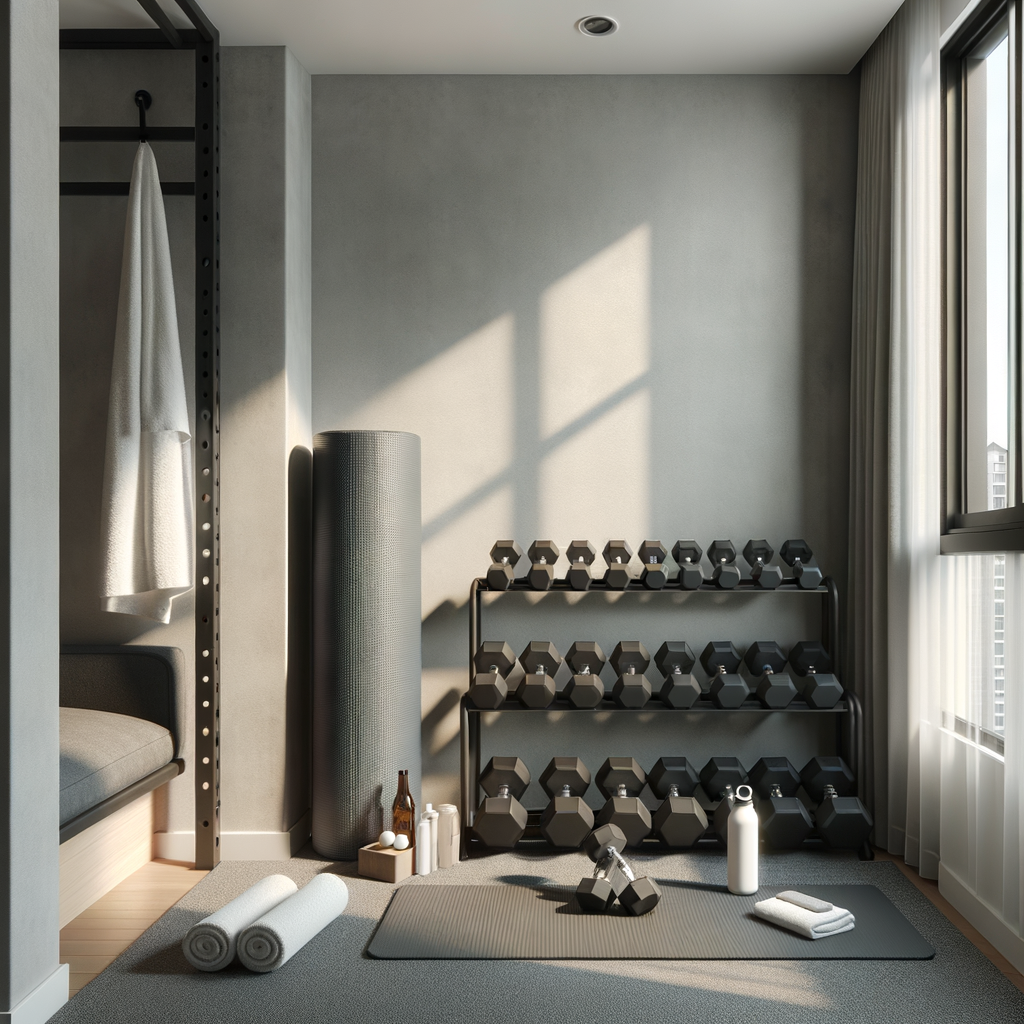


The dumbbell is one of the most versatile and effective pieces of exercise equipment you can have at home.
By creating a designated Dumbbell Corner, you’ll have everything you need close at hand to get a full-body strength workout.
I recommend starting with a set of adjustable dumbbells that allow you to change the weight plates as your fitness levels increase.
Look for a set that ranges from 5 to 50 pounds to grow with your needs.
To make the most of limited space, mount a vertical rack or shelf on the wall to store the dumbbells.
This keeps them neat and organized when not in use.
You can add removable pegs and labels to designate weight placement.
For exercises like bicep curls and shoulder presses that require standing, place a sturdy weight bench in front of the rack.
Opt for a padded multi-position bench that can also function as a seating area during rest periods.
Consider adding an ottoman or small storage container underneath to hold other small items like gloves, chalk, or a water bottle.
A wall-mounted mirror is great for checking form.
For motivation and new exercise ideas, you can decorate this Dumbbell Corner space with inspirational photos or posters.
✨Click to Get My 101 FREE Designer Room Ideas
Pull-Up Bar


A pull-up bar is one of the most effective and versatile pieces of equipment you can have for your upper body and core.
It requires no power and takes up minimal space, making it perfect for bodyweight training at home.
There are a few different options for installing a pull-up bar depending on your space.
For a rental or if you can’t make permanent changes, look for a portable, freestanding model that is height adjustable.
Some feature sandbags or wide bases for stability.
You can also mount pull-up bars into a doorway using a sturdy mounting bracket for a semi-permanent setup.
Measure the height carefully so it clears the top of the door frame when fully opened or closed.
For a more permanent installation, consider mounting the pull-up bar on ceiling joists in the basement, garage or other suitable room.
Reinforce the joists if needed and ensure the bar is securely mounted using lag bolts.
Aside from pull-ups, you can use the bar to perform chin-ups, inverted rows, front levers and other bodyweight routines.
Consider keeping a yoga mat near the bar for exercises like L-sit pull-ups or toe-to-bar.
Kettlebell Hub & TRX Suspension Station


If you’re looking to maximize your workouts while minimizing the space you use, a kettlebell hub paired with a TRX suspension station is the ultimate solution.
These two pieces of equipment are compact, versatile, and powerful enough to give you a full-body workout without the need for bulky machines.
With just a small area and a little setup, you can create a dynamic fitness space that works for strength, cardio, and mobility training.
The Kettlebell Hub
Kettlebells are one of the most versatile tools you can own.
They’re small enough to store in a basket, a corner, or even under your couch, but they pack a serious punch when it comes to functionality.
With a single kettlebell, you can perform a range of exercises that target your legs, arms, core, and back.
Moves like kettlebell swings, goblet squats, and Turkish get-ups are fantastic for building strength and endurance.
Kettlebell workouts are also incredibly efficient, combining cardio and resistance training into one session.
If space is a concern, consider investing in an adjustable kettlebell.
This allows you to change the weight as needed without cluttering your space with multiple pieces of equipment.
Simply store it in a designated spot, like a small shelf or basket, and you’re good to go.
You’ll just need a small workout mat or a rubber mat underneath to protect your floors during dynamic movements.
The TRX Suspension Station
The TRX suspension trainer is another MVP for small-space gyms.
It’s lightweight, portable, and can be set up in minutes.
You can anchor it to a sturdy door, wall, or even take it outdoors and attach it to a tree or a pole.
The TRX uses your own body weight as resistance, making it highly customizable for beginners and advanced fitness enthusiasts alike.
Exercises like TRX rows, chest presses, and lunges challenge your strength, stability, and core all at once.
It’s perfect for building functional fitness, improving balance, and working on flexibility.
When you’re done, the straps can be easily packed into a small bag or left hanging for quick access.
The Perfect Pair
What makes kettlebells and TRX such a winning combo is how they complement each other.
You can alternate between the two for a balanced, full-body workout.
For example, start with kettlebell swings to activate your posterior chain, then move to TRX rows to hit your back and arms.
You could also perform circuits, switching between kettlebell goblet squats and TRX lunges to work your lower body from different angles.
Both tools are compact and easy to store, making them ideal for a home gym setup.
With just these two pieces of equipment, you can create a highly effective workout space that fits seamlessly into your home.
Jump Rope Corner
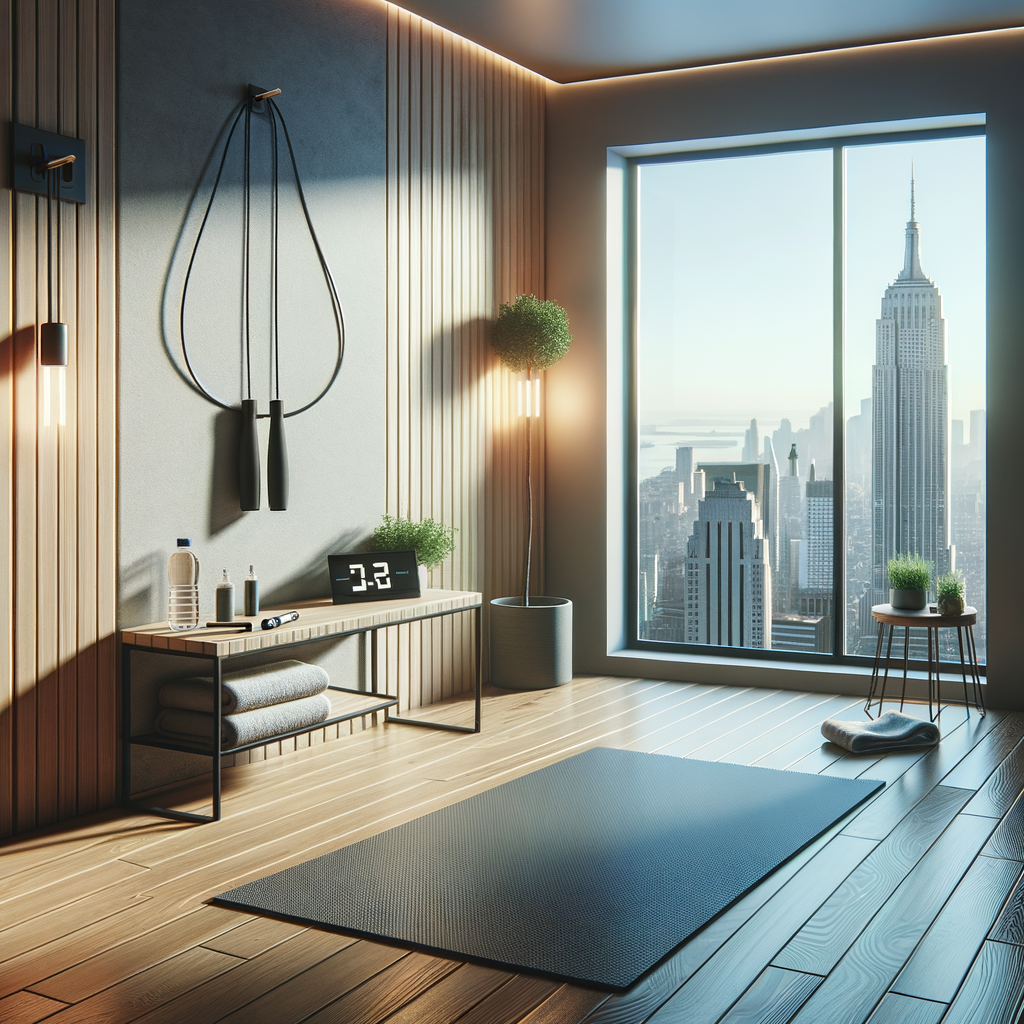
Designate a small area near an outlet where you can plug in a Bluetooth speaker for entertainment while exercising.
This dedicated space will keep jump ropes and related equipment organized and out of the way.
Mount a small floating shelf low on the wall to hold several different weighted jump ropes of various speeds and weights.
Add hooks underneath to hang ropes when not in use.
Include speed ropes for rapid-fire interval training as well as heavier ropes for building strength and power.
Rope handles come in different weights to challenge you.
On the floor below, place a puzzle exercise mat or turf to soften impact and absorb noise.
This protects your floors and joints.
Store an agility ladder alongside ropes to add footwork drills and coordination exercises to your routine.
Roll it up tightly when finished.
Keep track of jump stats and programming ideas on a wipe-off whiteboard mounted nearby.
Draw inspiration from boxing-inspired drills.
Consider LED rope lights that sync to your music for added motivation and safe low-light jumping wherever you set up this space.
Jumping ropes anywhere in your home is a fantastic callisthenic for conditioning.
This dedicated corner keeps the necessary gear organized and accessible.
Wall Mounted Rings
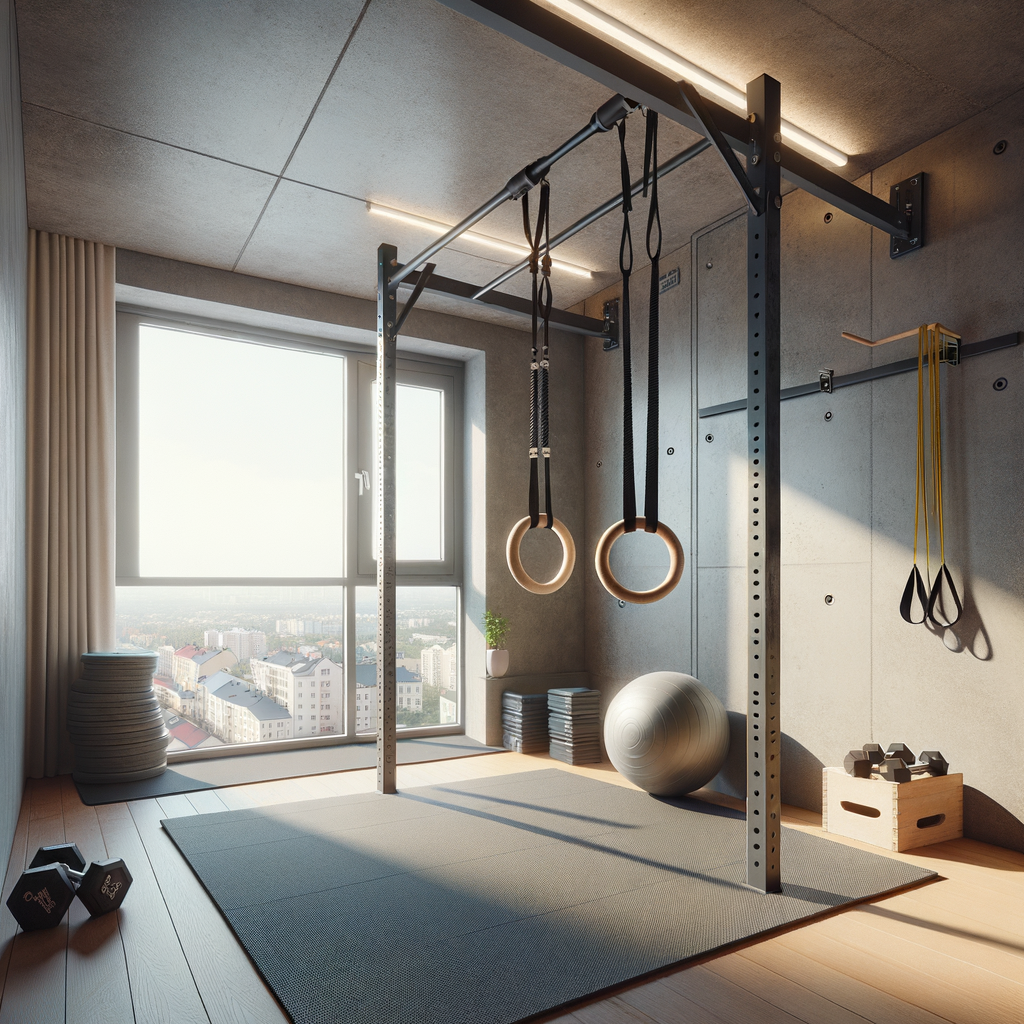
Gymnastic rings open up an extensive array of calisthenics bodyweight exercises.
Ensure your walls can safely support their weight and dynamic movements.
Install two rings positioned shoulder-width apart using heavy-duty ceiling hooks screwed securely into ceiling joists or wall studs.
test sturdiness before exercising.
Rings require clearance above and below for exercises like muscle-ups, L-sits and skin-the-cats.
Mount higher than standard pull-up bars to allow for momentum swings.
Start with basic progressions like ring rows, pushups and inverted hangs to build strength in supporting muscles.
Work up to more advanced ring work.
Consider placing a crash mat below rings to cushion dismounts and mistakes as skills progress.
Mark a clear area around equipment with tape.
Post a large roster of possible ring exercises nearby for motivation and variety.
Track progress videos.
Rings develop total body control and strength in a unique way.
Their versatility and challenging nature packs big results into minimal space needed.
Properly mounted gymnastic rings provide an extensive calisthenics option for any home that can accommodate their installation and dynamic fluid movements.
✨Click to Get My 101 FREE Designer Room Ideas
Cable Machine Center

A versatile cable machine takes up minimal floor space but enables a huge range of targeted exercises.
Look for compact models.
Place the machine against the wall to minimize its footprint.
Add wheels or sliders underneath for easy repositioning if needed.
Cable machines offer variable resistance comparable to gym machines.
They work large and small muscles via push, pull and rotational movements.
Store extra pulleys and cables on wall-mounted racks or shelves near the machine to customize workout stations.
Label each attachment.
Consider portable standalone fitness cables that can anchor to a sturdy basement joist or upstairs room for flexible operation.
Use exercise posters or a large routine sheet mounted nearby to learn new cable-specific exercises and stretches regularly.
Incorporate upper body, lower body and core moves into full-body circuits using just the machine and attached cables.
Cable machines are versatile workout multiplier and tissue-friendly exercise tool for any small-space home gym.
Rerun cable attachments as fitness levels advance.
A quality cable machine maximizes resistance training benefits with minimal floor space requirement in any home gym layout.
Turf Area

Designate a section of floor for exercise mats or interlocking foam tiles for floor exercises, yoga and stretching.
Look for padded turf tiles that resemble real grass for low-impact workouts.
They absorb shock and provide cushioning to protect joints.
Lay down the turf tiles to create a defined area where it’s safe and comfortable to exercise directly on the floor.
Roll up turf tiles tightly and tie with bungee cords or store in bins underneath when not in use to save space.
Consider placing this turf zone near other floor equipment like the pull-up bar or TRX station for compound exercises.
Use the cushioned turf space for routines involving planks, pushups, ab work, stretches and bodyweight flows.
Add exercise blocks, bands or hand weights to the routines for variety and increased challenge.
A defined turf area maximizes floor exercises with comfort in a small home gym space.
It adds another modality to your training.
Designating exercise turf protects hard floors while enabling full-range joint-friendly movements anywhere in your home.
Spin Bike Spot
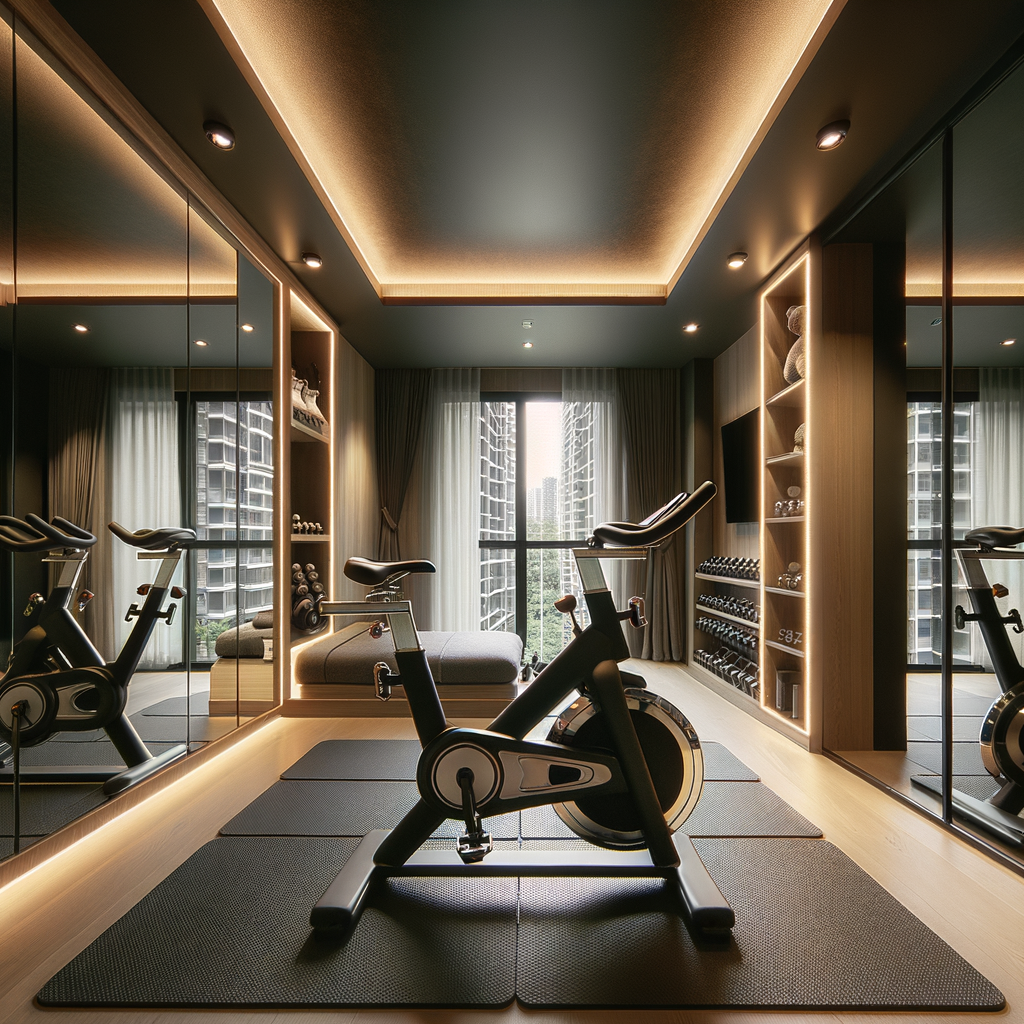
Even compact indoor cycles are large, so choose the smallest footprint model that meets your needs.
Some fold up more compactly.
Place the spin bike near an outlet to power a device for virtual classes.
Mount a TV above or position a tablet holder at eye level.
Allow enough clearance around the bike for safe pedaling.
Add a small fan nearby to keep the rider from overheating during intense sessions.
Consider sturdy floor mats underneath and behind the bike to absorb sweat and provide traction while cycling in different positions.
Keep towels on a shelf or rack nearby to wipe down the bike seat and handles thoroughly after each use.
Store headphones, water bottles and other small accessories on the floor behind the bike or under the mats while exercising.
Post or store cycling-specific workout routines and schedules to stay motivated on reaching fitness milestones.
Cardio is essential for the mini home gym.
A dedicated bike spot allows focused cycling anywhere, anytime.
A thoughtfully organized spin bike area maximizes both cardio benefit and space optimization in a tiny home gym.
Bootcamp Shelf
A bootcamp shelf is perfect for storing small portable equipment essential for bodyweight training sessions.
Mount a floating shelf low on the wall near your designated training areas like the mat or kettlebell zone.
Organize the shelf by function – cluster resistance bands of varying strength together, ball sizes together, etc.
Consider short risers or labeled dividers underneath the shelf to keep items neatly separated.
Accessories like sliders, discs, steps, gliders and balls all add variety without requiring much space.
Rotate through different boo camp circuits using only the portable pieces laid out from the shelf each session.
Draw workout routines and attach to the shelf for inspiration on moves to supplement other equipment.
Portable accessories open up countless new exercises with no power needs or footprint when stored together accessibly.
An organized bootcamp shelf is the perfect compact way to incorporate functional training variety into any minimal mini gym space.
✨Click to Get My 101 FREE Designer Room Ideas
Medicine Ball Caddy
Medicine balls are versatile for building power, strength and core stability.
Store them accessibly on a wall-mounted caddy.
Look for an adjustable shelving unit or floating shelves with enough space for multiple ball sizes.
Wood or metal materials hold weight well.
Clearly label compartments by ball weight so they are easy to identify during dynamic exercises.
Consider adding wheels or sliders under the caddy for easier repositioning against walls as your space layout changes.
Post routines emphasizing slams, passes and exercises on the adjacent wall for drill ideas and progression challenges.
Wall-mount the caddy at a height that is easy to access balls but protects higher wall spaces from potential impact.
Spot clean and wipe down medicine balls regularly to promote hygiene in shared living spaces.
Keeping weighted balls organized on convenient wall space saves floor footprint perfect for apartments or townhomes.
A medicine ball caddy keeps dynamic training accessible while preserving precious square footage.
Rowing Machine Nook
Look for compact rowers that can seamlessly fit into unused corners or spaces under stairs/shelves.
Some models fold vertically.
Allow clearance all around for safe foot placement and machine movement during the rowing stroke.
Install anti-slip rubber floor mats underneath and beyond the rower’s footprint to protect delicate floors.
Mount a shelf or racks above and on both sides to conveniently store the oar handles and any accessories like sliders when not in use.
Position a small fan and place hooks for a towel within reach to keep comfortable during cardio sessions.
Stores like under stairwells are perfect nooks to discretely integrate rowing machines without taking up living space.
Having rowing so conveniently placed encourages fits of low-impact interval training anywhere, anytime at home.
Rowing sculpts the entire body and defines the back like no other equipment in a small package.
With an organized nook, row machines are accessible yet protected in tight gym layouts.
15+ Mini Gym Setups: Photo Gallery
